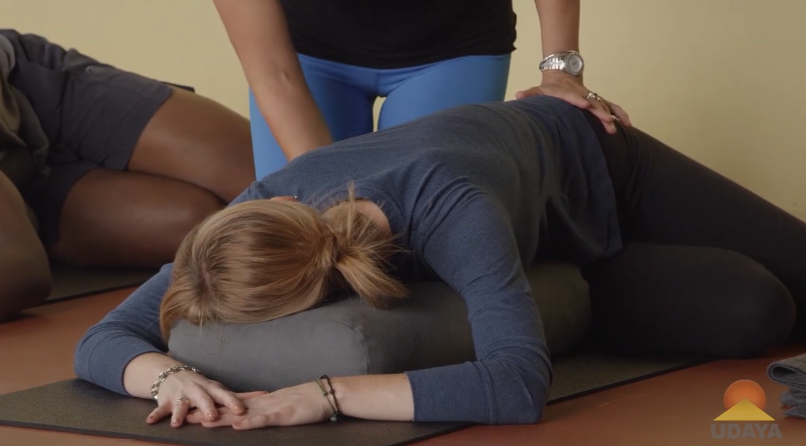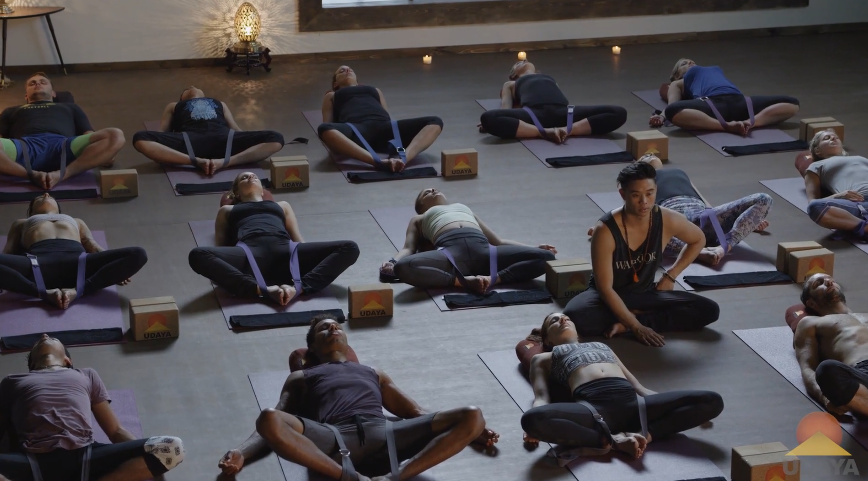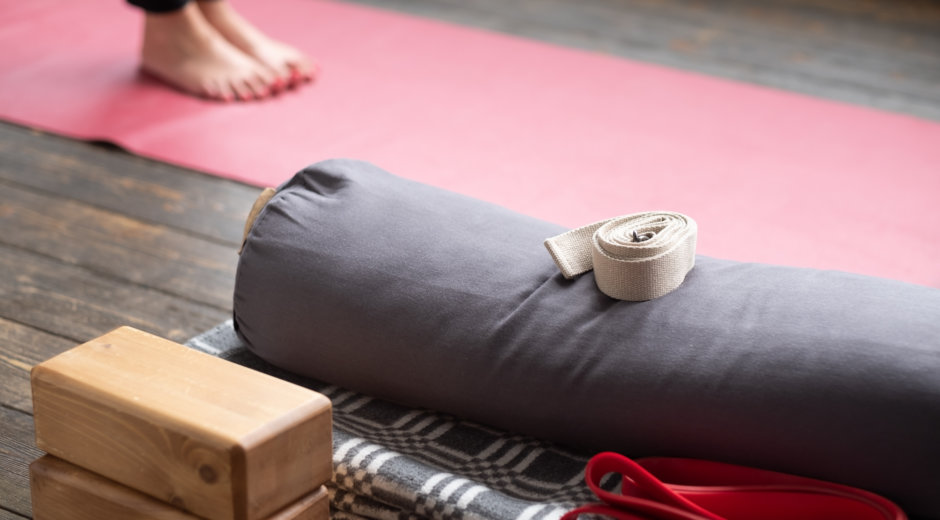All you need is an open mind and your yoga mat, right? Yes….. and you also might benefit from having a few yoga props available. Setting up a designated space at home, a little sanctuary for yourself to unwind and reconnect, is a small thing you can do for yourself that will provide endless benefits. Adding a few props, which you can use to support yourself along the way and experience the benefits of yoga, is a very smart choice.
Here in this video, Jules Mitchell gives a quick review of the common yoga props for you to consider incorporating into your practice.
Yoga Chair
Let’s start with a less known piece of yoga equipment. When you think ‘yoga chair’ you probably think about the style of yoga called Chair Yoga, which is key for yoga practitioners who need to support their lower body by utilizing a chair. And yes, of course, you need a chair for Chair Yoga but beyond this utilization, there are many other creative uses. A yoga chair can be used to support and deepen backbends, to open shoulders, and to deepen seated twists, and many other poses. Adding this prop to your yoga space and trying out new techniques can open up so many possibilities.

Yoga Blanket
You’ve most likely experienced using a yoga blanket while taking a restorative yoga class. Commonly a blanket will be placed under the small of the back or behind the shoulders for added support and to add in complete relaxation. And no one can forget the ultimate comfort of pulling a blanket over one’s body as it floats away in savasana at the closing of a restorative class. Blankets are also used in other styles of yoga practices like Hatha and Vinyasa to add support and cushioning in a variety of different poses. For example, to protect sensitive knees one might place a blanket between the knee and the mat while in a low lunge pose. While in hero pose, one could sit on a folded blanket to give elevation to the torso and therefore protect the knees and ankles.

Yoga Bolster
Just like the yoga blanket, you will see the bolster often used in restorative classes. And just like the blanket, the bolster is used to support different parts of the body and provide optimum comfort (think floating on a cloud with no joints making contact with the hard surface of the floor). Because of the size and shape of the bolsters, they offer more elevation and a softer cushion than a blanket. Bolsters come in a couple of shapes, round and rectangular and they are mostly interchangeable. If you are adding to your home studio’s yoga props inventory, we recommend this one. Try each shape out in a studio and determine which one you prefer before purchasing.

Yoga Block
In every studio’s yoga props closet, you will find blocks. It is used in many types and styles of yoga. Yoga blocks come in a few different sizes and materials. The classic yoga block is 4″ x 6″ x 9″ and made from cork. A lot of props companies also sell blocks made from foam, which are softer and lighter, and also blocks made of wood which are harder and heavier. Like with all things, it’s up to your personal preference, but if you are buying a block for the first time, we say go with the classic cork version. It offers solid support, doesn’t flip easily, and is light enough to move about with ease. And our only other tip in regards to blocks is to get your ego out of the way. Some may think that blocks are like training wheels and ‘advanced yogis’ don’t need training wheels, But this is garbage thinking. If you have shorter arms you may benefit from a block in triangle pose. If you have longer arms you may not need one. This has everything to do with anatomy and nothing to do with whether or not you have an advanced practice.

The FeetUp Trainer
The FeetUp Trainer is a relatively new product but one we had to include in this list of OG yoga props! This product helps you achieve inverted postures without putting pressure on your head. Your body weight is spread across your shoulders, your shoulders are supported by the FeetUp and your head hangs without touching the ground. It makes getting inverted much more accessible with minimal fear of crashing into the coffee table. Very cool in our books. How did no one think of this earlier?


Yoga Strap
A yoga strap really is such a versatile tool! You can benefit from using a strap in standing poses, a seated poses, balancing poses, reclining poses….so many options here. It is mostly used in assisting with stretching and increasing range of motion. A strap can be used as an extension of the body. For example, if you can’t touch your toes in seated forward fold you can hook the strap under your feet and walk your hands closer down the strap towards your feet. A strap will offer help with support when you need it and with alignment when you don’t realize that you need it. If you have tight hamstrings and locked-up shoulders, you will love using a strap.

Meditation Cushion
You can certainly use a bolster or a rolled-up blanket underneath you in sitting meditation, but a circular meditation cushion also called a zafu, does provide a level of comfort above these other options. Zafus are filled most commonly with buckwheat, which makes it heavy and solid to sit on. And as anyone who has enjoyed sitting in a bean bag chair will tell you, the key to finding the perfect fit is just a little bit of wiggling. To sit comfortably in meditation you want your spine to be erect yet feel restful, and unstrained. To be able to achieve this a meditation cushion is your best friend. Sit cross-legged on the cushion with your knees on the floor in front of you, and wiggle about so that your seat is comfy. With your hips higher than your knees, an ideal foundation has been created as support for a tall, straight spine. As with anything, this may take getting used to. If you are new to mediation, we recommend sitting every day but for short amounts of time. Don’t blow yourself out or get discouraged because you can’t sit for 30 minutes on the first go. Dedicate yourself to five minutes a day for a week or two, until you feel that you can move it up to ten minutes. And acknowledge that starting a mediation practice is a big accomplishment.

We hope you learned a bit about yoga accessories and are inspired to try some out and experience your yoga practice in new ways!


Write Your Comment
Leave a comment